Filipino cuisine is becoming increasingly popular around the world, and it’s not hard to see why. It’s full of vibrant flavors and tradition-rich recipes—and every dish tells a story. But when you live outside the Philippines, some crucial ingredients like calamansi, bagoong, or fresh banana hearts can be tricky to find.
At Remitly, we love to help people enjoy their traditions even while exploring new parts of the world. If you’re craving Filipino food, whether you’re a homesick expat or just a curious cook, we can help.
In this article, we’ll go over some practical and easy ingredient swaps for beloved Filipino dishes like adobo, pancit, and kare-kare. You’ll be able to get close to the flavors of the Philippines anywhere in the world with these smart ingredient swaps.
Why use Filipino recipes with ingredient substitutions?
The Filipino diaspora has made it easier to find Filipino grocery stores that can provide you with authentic ingredients. Still, not everywhere has enough of a community to support a Filipino food store. It can be hard to get the ingredients you need, but substitutions mean that you don’t have to give up on cooking your favorite foods.
Substituting ingredients can also help with dietary needs. For example, you can make vegetarian kare-kare by switching the meat for mushrooms or eggplant, and miso in place of bagoong (shrimp paste). Likewise, you can replace the soy sauce in adobo with tamari to make it gluten-free (check the label to ensure it’s gluten-free). These substitutions open up the authentic flavors of Filipino food to anyone.
Purists may insist on doing things the way they’ve always been done, but cooking is all about the flavor you get at the end. The right substitutions can help you enjoy the essence of Filipino food by tweaking recipes just a little based on what’s available to you.
Essential ingredient substitutions for common Filipino recipes
Not being able to find traditional ingredients doesn’t mean you can’t enjoy Filipino food. While these swaps won’t be exact matches, they are easy substitutions to either replace ingredients you can’t find or make dishes more suitable for people with special dietary requirements.
Adobo
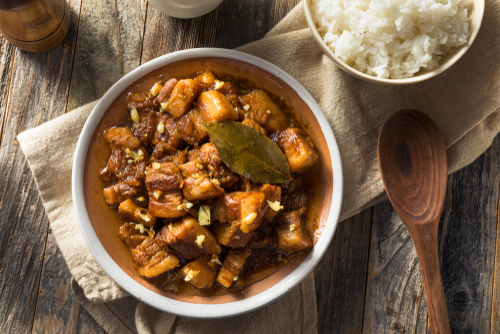
A savory and tangy stew made with meat (usually pork or chicken) simmered in soy sauce, vinegar, garlic, bay leaves and black pepper
Soy sauce: Coconut aminos or tamari (check the label) can maintain the depth of savory flavor you need, while eliminating the gluten that’s in soy sauce. They also have less sodium than soy sauce, making them more suitable for low-sodium diets. Plus, they bring a slight sweetness to the dish that beautifully balances the vinegar.
Cane vinegar: Distilled white vinegar and rice vinegar have a mild acidity that is the closest match to traditional cane vinegar, without overpowering the other flavors in the dish. Apple cider vinegar could also work if you prefer a fruitier note.
Sinigang
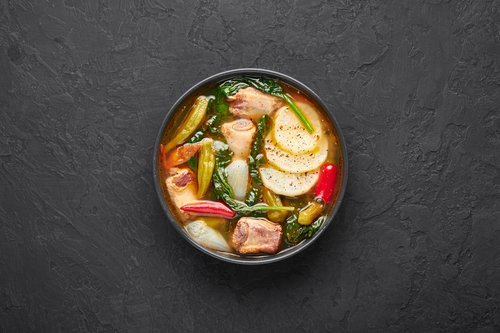
A sour soup filled with vegetables and flavored with tamarind
Tamarind: If you can find tamarind concentrate, that’s probably your best bet. If that’s not available, use green mango or a splash of vinegar. You could also try mixing lemon or lime juice with brown sugar to give you a sweet-and-sour taste that can approximate the traditional tamarind tang.
Fish sauce: If you want a vegetarian version, use soy sauce to add saltiness and umami flavor. You can also add miso paste to bring in that fermented depth that fish sauce usually gives you, though it won’t be quite as pungent.
Pancit
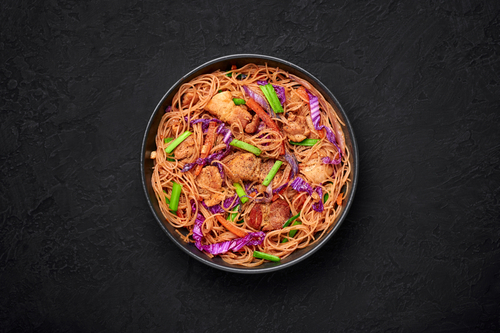
Stir-fried noodles with meat, seafood and vegetables
Noodles: If you can’t find rice vermicelli (bihon), other rice noodles make a good replacement. If you’re really stuck, try thin wheat noodles like angel hair pasta.
Sauce: To make vegetarian pancit, replace oyster sauce by mixing some brown sugar and soy sauce to give you that sweet-savory balance. You could also try hoisin sauce, but bear in mind that hoisin sauce is more strongly spiced, so the flavor profile is quite different.
Kare-kare
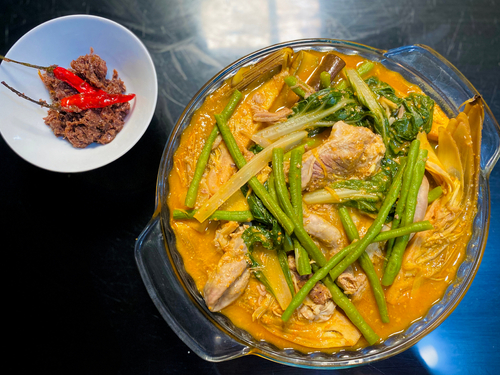
A peanut-based stew, traditionally served with shrimp paste
Peanut sauce: Other nut butters, like cashew and almond, will give you a similar texture to the traditional peanut sauce, though the flavor will differ slightly.
Shrimp paste: If you can’t get bagoong where you are, fermented miso paste or black bean paste can bring some umami depth to the dish.
Halo-Halo
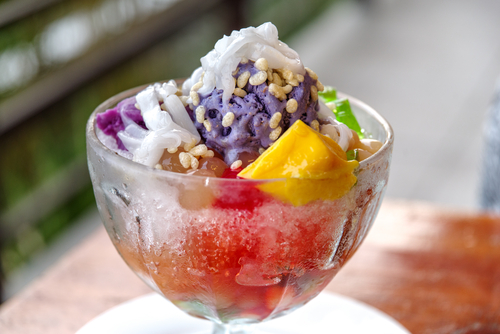
A colorful dessert made from shaved ice and layered with fruits, jellies, and other toppings
Ube halaya: Ube halaya has a unique flavor, but you can mash purple sweet potato with a touch of condensed milk to give you the color and sweetness.
Leche flan: For something similarly sweet and creamy, look for crème caramel or caramel custard.
Lumpia
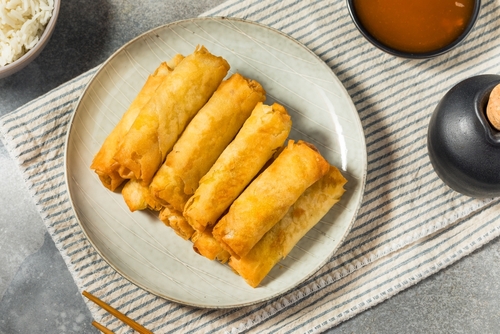
Crispy spring rolls filled with meat and vegetables
Wrappers: Spring roll wrappers and egg roll wrappers can work when you can’t get authentic lumpia wrappers. Note that you might need to adjust the cooking time to get the right level of crispiness. For a gluten-free option, try rice paper.
Filling: To make vegetarian lumpia, you can replace the ground pork with mushrooms, grated carrots, cabbage, or tofu.
Tips to ensure flavor authenticity
Having the right ingredients is key to harnessing those incredible flavors of the Philippines. However, using the right techniques will also go a long way to help you create memorable meals.
- Boost flavors with aromatics: Staples like garlic, onions, ginger, and bay leaves (dried laurel) are available almost anywhere, and they add a powerful kick to dishes. Incorporate these seasonings to keep things tasty and fill in any gaps left by ingredient substitutions.
- Adjust as you go: Don’t forget to taste test throughout the cooking process. Sometimes, an ingredient substitution can change the flavor of a dish, but you can get the right balance by adding a bit more salt, sugar, or acid.
- Stock up: If you can’t do without the real thing, consider stocking up and buying in bulk when authentic ingredients are available. Online sources like Seafood City Online and Asian Food Grocer can help you find what you need wherever you are.
Ingredient substitutions for healthier options
Sometimes, ingredient swaps are less about availability and more about health. The good news is, you can keep that rich depth of taste while reducing calories and improving nutrition, making your meals lighter or a bit more nutritionally balanced.
- Use low-sodium soy sauce in adobo and pancit. You probably won’t notice a big difference in flavor, but it will help to keep your salt consumption down.
- Try light coconut milk in creamy dishes like ginataang gulay. This will cut down on the fat content without sacrificing that smooth texture.
- Natural sweeteners like coconut sugar or honey can add complexity to dishes that call for sugar, without using refined sugar.
The key is to keep every dish’s core flavor elements intact. That means preserving the balance of sweet, salty, sour, and umami. Don’t be afraid to experiment with different ingredients to get the perfect balance.
Building your Filipino pantry abroad
It’s much easier to preserve Filipino flavors when you have a well-stocked pantry. There are some items you should try to always keep in stock, as these versatile ingredients can help keep any dish traditional.
Essential ingredients include:
- Fish sauce (patis): Add salty umami to soups, stews, and sauces
- Soy sauce: A must-have ingredient for adobo, marinades, and more
- Calamansi juice: Bottled or frozen versions can give the citrusy tang of fresh calamansi.
- Banana ketchup: A sweet and tangy sauce often used in Filipino dishes
- Cane vinegar or coconut vinegar: Vinegar is the foundation of many marinades and stews.
- Coconut milk: An essential ingredient for creamy dishes
- Rice: A Filipino staple
- Dried laurel leaves: A key flavoring
- These ingredients form the flavor base of plenty of Filipino dishes, so they can help you get the taste you’re looking for.
Many major cities now have Filipino grocery stores, or more general Asian supermarkets, where you may find a Filipino section. You can also find international Filipino grocery stores like Lili Mart, Island Pacific Market, and H Mart. Even Amazon may have some good finds from time to time.
How to cook Filipino food at home
Food provides a connection to home and culture for Filipinos around the world—and Filipino food is increasingly being enjoyed by non-Filipinos who appreciate its vibrant flavors. Being able to substitute hard-to-find ingredients makes this fantastic national cuisine more accessible for everyone.
Substituting ingredients doesn’t have to mean compromising. Instead, the right substitutions can preserve the heart of a dish while allowing you to use local ingredients and adapt recipes to fit dietary requirements.
Use these tips to guide you, and don’t be afraid to experiment for yourself. Sometimes, the best recipes are made by trying new things, so get creative in the kitchen. No matter where you are, you can let the flavors of the Philippines make you feel at home.
FAQs
What can I use instead of calamansi in Filipino recipes?
If you can’t get calamansi locally, you can use lemon or lime to give a similar citrus tang. You can also combine the two for a richer depth of flavor.
Will substitutions change the taste of traditional dishes significantly?
Some substitutions can alter a dish’s flavor profile. That’s why it’s important to taste as you go and make adjustments. Adding a little more salt, sugar, or vinegar can help balance any ingredient substitution you have made so that you can preserve the essence of Filipino cuisine.
Where can I find Filipino ingredients abroad?
Look for Asian grocery stores that will carry Filipino staples. Specialty Filipino online grocery stores can also offer a great selection of ingredients, if they are available where you are.
What are common ingredients in Filipino food?
Filipino cuisine is built on a balance of savory, sweet, salty, and sour flavors, provided by a range of key ingredients: soy sauce, vinegar (cane, coconut, or palm), fish sauce, garlic, onions, ginger, calamansi (Filipino lime), coconut milk, banana ketchup, annatto seeds, tamarind, and bay leaves.